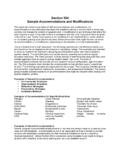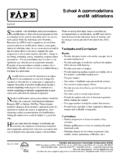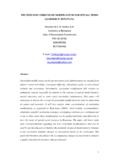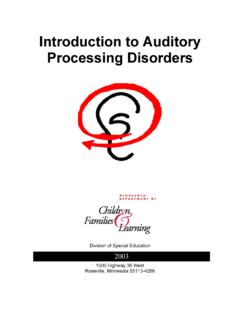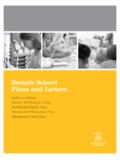Transcription of The University of the State of New York • The State ...
1 Sample individualized education Programand guidance DocumentOffice of Vocational and Educational Services for Individuals with University of the State of New York The State education DepartmentNEW YORK State education DEPARTMENTSAMPLEINDIVIDUALIZED education PROGRAM(IEP)AND guidance DOCUMENTThe University of the State of New YorkThe State education Department Office of Vocational and EducationalServices for Individuals with DisabilitiesAlbany, New York 12234 December 20021 IINNTTRROODDUUCCTTIIOONN Improving educational results for children with disabilities is an essential element of ournation s policy of ensuring equality of opportunity, full participation, independent livingand economic self-sufficiency for individuals with disabilities.
2 (Congress, 1997, IDEAR eauthorization)This publication provides a guide on the logical sequence of events to develop anindividualized education program (IEP) and how information should/must bedocumented in the IEP. However, it can only serve to reinforce the new direction forIEPs if the members of the Committees on Special education , parents and other schoolpersonnel embrace the concepts intended by Congress as outlined NEW DIRECTION FOR IEPS: MAKING THE SHIFT MAKING A DIFFERENCE The IEP is the cornerstone of the special education process for each individualstudent.
3 It is the tool to document how one student s special needs will be met withinthe context of an educational environment. The IEP development process andimplementation needs to be premised on the research and experience that has shownthat, to improve results for students with disabilities, schools must: have high expectations for students with disabilities; ensure their access in the general education curriculum to the maximum extentpossible; strengthen the role of parents; ensure that families have meaningful opportunities to participate in the education oftheir children at school and at home.
4 Ensure that special education is a service, rather than a place where students aresent; provide appropriate special education services, aids and supports in the generaleducation classroom, whenever appropriate; ensure that all those who work with students with disabilities have the skills andknowledge necessary to help such students to meet developmental goals and, to themaximum extent possible, those challenging expectations that have beenestablished for all children, and to prepare them to lead productive independent,adult lives, to the maximum extent possible.
5 2 provide high quality research-based instruction and supports to all students who areexperiencing learning difficulties to reduce the need to label children as disabled inorder to address their learning needs; and focus resources on teaching and learning. DEVELOPING IEPS LINKED TO THE STANDARDS The New York State Standards apply to all students, regardless of their experientialbackground, capabilities, developmental learning differences, interests or ambitions. There aremultiple pathways to learn effectively, participate meaningfully and work towards attaining thecurricular standards.
6 Students with diverse needs may need accommodations and/oradaptations of instructional strategies and materials to enhance their learning and/or adjust theirlearning capabilities. (Learning Standards for English-Language Arts, New York StateEducation Department, March 1996).The New York State Learning Standards include learning standards,performance indicators and sample tasks a student is expected to know or demonstrateat different levels (alternate, elementary, intermediate and commencement). Standardsshould serve as the basis for developing instructional means that members of a Committee on Special education will need toconsider both the standards as well as the school-based instructional curriculum, whichshould be aligned to the standards.
7 They will need to know the expectations of thegeneral education classroom for the corresponding age of the student both in terms ofwhat learning is expected (general curriculum) as well as how the students areexpected to access/demonstrate that learning. This information will assist theCommittee to determine if the student needs adaptations, accommodations, ormodifications to the general curriculum for all or part of his/her learning. This is onereason it is important for the general education teacher(s) to participate in theCommittee meetings and for the school district representative to be knowledgeable ofthe general education curriculum.
8 To develop IEPs that are linked to the standards, the Committee should:1. Review the content as well as the expectations for how the student will learn ordemonstrate knowledge and skill in the content Identify the strengths and challenges for the student in relation to those expectationsin the present levels of performance section of the Identify how a student s needs are linked to the general curriculum ( , learning touse a switch device is linked to communication or reading). 34. Identify goals and short-term instructional objectives or benchmarks that areindividualized for the student, and yet linked to the general curriculum.
9 A student sgoals and objectives on an IEP should not be a re-statement of a standard or acurriculum goal, but rather a statement that reflects the necessary learning that willlead to attaining a standard. For example, a student may have goals to acquireessential learning strategies that will help him or her better meet the expectationsaround how to learn the Identify adaptations, accommodations, or modifications to the general curriculum asneeded by the IEP AS THE CORNERSTONE OF THE SPECIAL education PROCESSThe IEP is a strategic planning document that should be far reaching in itsimpact.
10 An IEP identifies a student s unique needs and how the school will strategicallyaddress those needs. IEPs identify how specially designed instruction will be providedin the context of supporting students in general education programs and in reaching thesame learning standards as nondisabled students. IEPs guide how the resources of aschool will be configured. IEPs identify how students will be incrementally prepared foradult living. IEPs also provide an important accountability tool for school personnel,students and parents. By measuring students progress toward goals and objectives,schools should use IEPs to determine if they have appropriately configured how theyuse their resources to reach the desired outcomes for students with disabilities.




